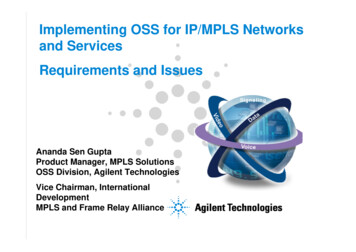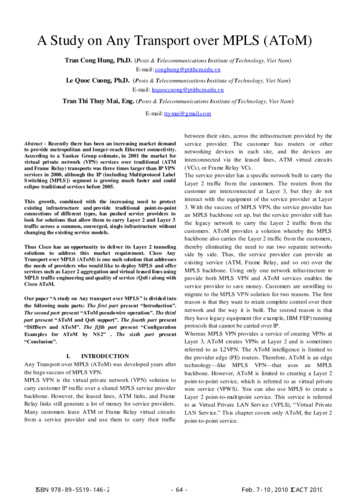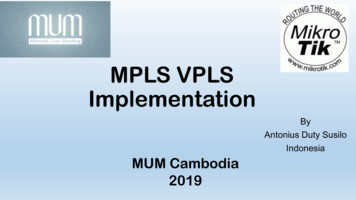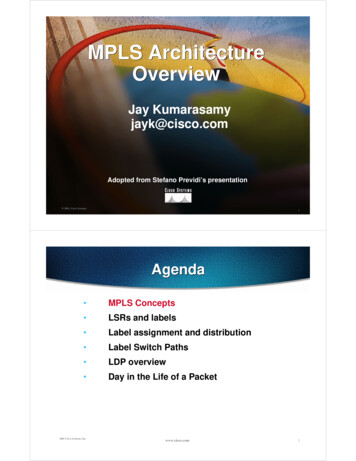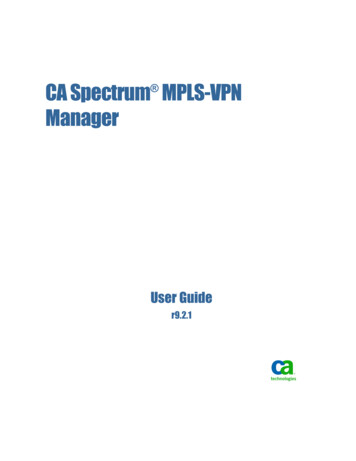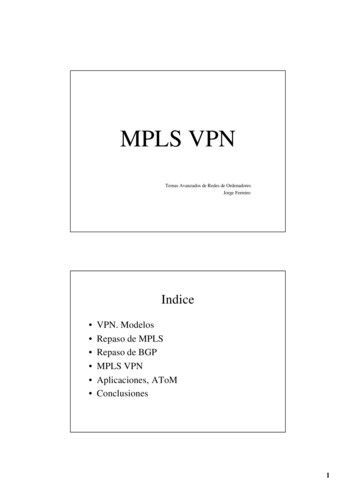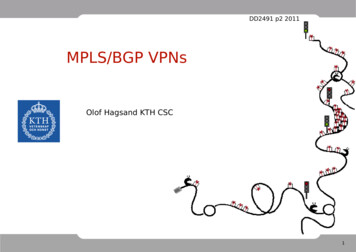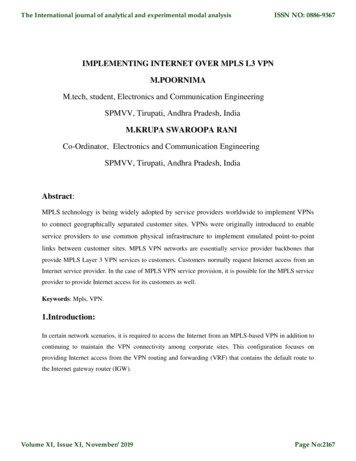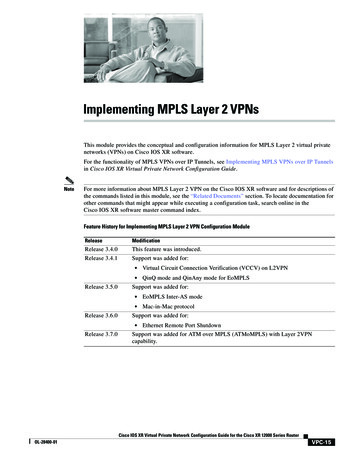
Transcription
Implementing MPLS Layer 2 VPNsThis module provides the conceptual and configuration information for MPLS Layer 2 virtual privatenetworks (VPNs) on Cisco IOS XR software.For the functionality of MPLS VPNs over IP Tunnels, see Implementing MPLS VPNs over IP Tunnelsin Cisco IOS XR Virtual Private Network Configuration Guide.NoteFor more information about MPLS Layer 2 VPN on the Cisco IOS XR software and for descriptions ofthe commands listed in this module, see the “Related Documents” section. To locate documentation forother commands that might appear while executing a configuration task, search online in theCisco IOS XR software master command index.Feature History for Implementing MPLS Layer 2 VPN Configuration ModuleReleaseModificationRelease 3.4.0This feature was introduced.Release 3.4.1Support was added for:Release 3.5.0Release 3.6.0 Virtual Circuit Connection Verification (VCCV) on L2VPN QinQ mode and QinAny mode for EoMPLSSupport was added for: EoMPLS Inter-AS mode Mac-in-Mac protocolSupport was added for: Release 3.7.0Ethernet Remote Port ShutdownSupport was added for ATM over MPLS (ATMoMPLS) with Layer 2VPNcapability.Cisco IOS XR Virtual Private Network Configuration Guide for the Cisco XR 12000 Series RouterOL-28400-01VPC-15
Implementing MPLS Layer 2 VPNsContentsRelease 3.8.0Support was added for Any Transport over MPLS (AToM) for: IP Interworking on Engine 3 and 5 Line Cards PPP/HDLC Like-to-Like Pseudowires on Engine 3 and Engine 5 Line Cards ATM Like-to-Like Pseudowires on Engine 3 and Engine 5 Line Cards Frame Relay DLCI, and MLFR Like-to-Like Pseudowires on Engine 3 LineCards Ethernet Port Mode and VLAN Like-to-Like Pseudowires on Engine 3 LineCards Local Switching Support with L2TPv3 on Engine 3 and Engine 5 Line CardsRelease 4.0.1Support was added for the ATM Interworking feature.Release 4.2.0Support was added for Any Transport over MPLS (AToM) for: IP Interworking support on cHDLC and PPP attachment circuits FR-to-Ethernet bridged interworking Local switching for PPP and cHDLCSupport was added for Circuit Emulation (CEM) over PacketRelease 4.3.0Support was added for these features: L2VPN nonstop routing (NSR) Pseudowire GroupingContents Prerequisites for Implementing MPLS L2VPN, page VPC-16 Information About Implementing L2VPN, page VPC-16 How to Implement L2VPN, page VPC-33 Configuration Examples for L2VPN, page VPC-75 Additional References, page VPC-84Prerequisites for Implementing MPLS L2VPNTo perform these configuration tasks, your Cisco IOS XR software system administrator must assignyou to a user group associated with a task group that includes the corresponding command task IDs. Allcommand task IDs are listed in individual command references and in the Cisco IOS XR Task IDReference Guide.If you need assistance with your task group assignment, contact your system administrator.Information About Implementing L2VPNTo implement MPLS L2VPN, you should understand the following concepts: L2VPN Overview, page VPC-17Cisco IOS XR Virtual Private Network Configuration Guide for the Cisco XR 12000 Series RouterVPC-16OL-28400-01
Implementing MPLS Layer 2 VPNsInformation About Implementing L2VPN ATMoMPLS with L2VPN Capability, page VPC-17 Virtual Circuit Connection Verification on L2VPN, page VPC-18 Ethernet over MPLS, page VPC-19 Quality of Service, page VPC-22 High Availability, page VPC-23 Preferred Tunnel Path, page VPC-23 Any Transport over MPLS, page VPC-24 Circuit Emulation Over Packet Switched Network, page VPC-31 L2VPN Nonstop Routing, page VPC-32 Pseudowire Grouping, page VPC-33L2VPN OverviewLayer 2 VPN (L2VPN) emulates the behavior of a LAN across an IP or MPLS-enabled IP networkallowing Ethernet devices to communicate with each other as they would when connected to a commonLAN segment.As Internet service providers (ISPs) look to replace Frame Relay or their Asynchronous Transfer Mode(ATM) infrastructures with an IP infrastructure, there is a need for to provide standard methods of usingan IP infrastructure to provide a serviceable L2 interface to customers; specifically, to provide standardways of using an IP infrastructure to provide virtual circuits between pairs of customer sites.Building a L2VPN system requires coordination between the ISP and the customer. The ISP provides L2connectivity; the customer builds a network using data link resources obtained from the ISP. In anL2VPN service, the ISP does not require information about a the customer's network topology, policies,routing information, point-to-point links, or network point-to-point links from other ISPs.The ISP requires provider edge (PE) routers with the following capabilities: Encapsulation of L2 protocol data units (PDU) into Layer 3 (L3) packets. Interconnection of any-to-any L2 transports. Emulation of L2 quality-of-service (QoS) over a packet switch network. Ease of configuration of the L2 service. Support for different types of tunneling mechanisms (MPLS, L2TPv3, IPSec, GRE, and others). L2VPN process databases include all information related to circuits and their connections.ATMoMPLS with L2VPN CapabilityThese topics describe the ATM over MPLS (ATMoMPLS) with L2VPN feature: ATMoMPLS with L2VPN Overview, page VPC-18 Layer 2 Local Switching Overview, page VPC-18 ATM Adaptation Layer 5, page VPC-18Cisco IOS XR Virtual Private Network Configuration Guide for the Cisco XR 12000 Series RouterOL-28400-01VPC-17
Implementing MPLS Layer 2 VPNsInformation About Implementing L2VPNATMoMPLS with L2VPN OverviewThe ATMoMPLS feature supports ATM Adaptation Layer 5 (AAL5) transport. ATMoMPLS is a type ofLayer 2 point-to-point connection over an MPLS core. ATMoMPLS and ATM local switching aresupported only for ATM-to-ATM interface-to-interface switching combinations.To implement the ATMoMPLS feature, the Cisco CRS-1 router plays the role of provider edge (PE)router at the edge of a provider network in which customer edge (CE) devices are connected to theCisco CRS-1 routers.Layer 2 Local Switching OverviewLocal switching lets you to switch Layer 2 data between two interfaces of the same type (for example,ATM-to-ATM, or Frame Relay-to-Frame Relay) or between interfaces of different types (for example,Frame Relay to ATM) on the same router, over an IP core network. The interfaces are on the same linecard or on two different cards. During these types of switching, Layer 2 address is used instead of theLayer 3 address.In addition, same-port local switching lets you to switch Layer 2 data between two circuits on the sameinterface.ATM Adaptation Layer 5AAL5 lets you transport AAL5 PDUs from various customers over an MPLS backbone. ATM AAL5extends the usability of the MPLS backbone by enabling it to offer Layer 2 services in addition to alreadyexisting Layer 3 services. You can enable the MPLS backbone network to accept AAL5 PDUs byconfiguring the provider edge (PE) routers at both ends of the MPLS backbone.To transport AAL5 PDUs over MPLS, a virtual circuit is set up from the ingress PE router to the egressPE router. This virtual circuit transports the AAL5 PDUs from one PE router to the other. Each AAL5PDU is transported as a single packet.Virtual Circuit Connection Verification on L2VPNVirtual Circuit Connection Verification (VCCV) is an L2VPN Operations, Administration, andMaintenance (OAM) feature that allows network operators to run IP-based provider edge-to-provideredge (PE-to-PE) keepalive protocol across a specified pseudowire to ensure that the pseudowire datapath forwarding does not contain any faults. The disposition PE receives VCCV packets on a controlchannel, which is associated with the specified pseudowire. The control channel type and connectivityverification type, which are used for VCCV, are negotiated when the pseudowire is established betweenthe PEs for each direction.Two types of packets can arrive at the disposition egress: Type 1—Specifies normal Ethernet-over-MPLS (EoMPLS) data packets. Type 2—Specifies VCCV packets.Cisco IOS XR software supports Label Switched Path (LSP) VCCV Type 1, which uses an inbandcontrol word if enabled during signaling. The VCCV echo reply is sent as IPv4 that is the reply mode inIPv4. The reply is forwarded as IP, MPLS, or a combination of both.VCCV pings counters that are counted in MPLS forwarding on the egress side. However, on the ingressside, they are sourced by the route processor and do not count as MPLS forwarding counters.Cisco IOS XR Virtual Private Network Configuration Guide for the Cisco XR 12000 Series RouterVPC-18OL-28400-01
Implementing MPLS Layer 2 VPNsInformation About Implementing L2VPNEthernet over MPLSEthernet-over-MPLS (EoMPLS) provides a tunneling mechanism for Ethernet traffic through anMPLS-enabled L3 core and encapsulates Ethernet protocol data units (PDUs) inside MPLS packets(using label stacking) to forward them across the MPLS network.EoMPLS features are described in the following subsections: Ethernet Port Mode, page VPC-19 VLAN Mode, page VPC-20 VLAN Mode, page VPC-20 Inter-AS Mode, page VPC-20 QinQ Mode, page VPC-21 QinAny Mode, page VPC-22 Mac-in-Mac Protocol (Provide Backbone Bridging), page VPC-22Ethernet Port ModeIn Ethernet port mode, both ends of a pseudowire are connected to Ethernet ports. In this mode, the portis tunneled over the pseudowire or, using local switching (also known as an attachmentcircuit-to-attachment circuit cross-connect) switches packets or frames from one attachment circuit(AC) to another AC attached to the same PE node.NoteL2VPN forwarding using GRE tunnels is supported in the Ethernet port mode.Figure 1 provides an example of Ethernet port mode.Figure 1Ethernet Port Mode Packet FlowEtherCEEtherPEEtherPEEtherCEMPLS emulatedVC Type 5Tunnel labelPayloadVC labelControl WordControl WordPayloadPayloadPayloadPacket flowPayload158276PayloadVC labelCisco IOS XR Virtual Private Network Configuration Guide for the Cisco XR 12000 Series RouterOL-28400-01VPC-19
Implementing MPLS Layer 2 VPNsInformation About Implementing L2VPNVLAN ModeIn VLAN mode, each VLAN on a customer-end to provider-end link can be configured as a separateL2VPN connection using virtual connection (VC) type 4 or VC type 5. VC type 4 is the default mode.As illustrated in Figure 2, the Ethernet PE associates an internal VLAN-tag to the Ethernet port forswitching the traffic internally from the ingress port to the pseudowire; however, before moving trafficinto the pseudowire, it removes the internal VLAN tag.Figure 2VLAN Mode Packet FlowEtherCEEtherPEtaggedEtherPEMPLS emulatedEtherCEtaggedVC Type 5Tunnel labelVLAN tagPayloadVC labelControl WordControl WordPayloadPayloadPacket flowVLAN tagPayloadVLAN tagPayload158393VLAN tagPayloadVC labelAt the egress VLAN PE, the PE associates a VLAN tag to the frames coming off of the pseudowire andafter switching the traffic internally, it sends out the traffic on an Ethernet trunk port.NoteBecause the port is in trunk mode, the VLAN PE doesn't remove the VLAN tag and forwards the framesthrough the port with the added tag.NoteL2VPN forwarding using GRE tunnels is supported in the VLAN mode.Inter-AS ModeInter-AS is a peer-to-peer type model that allows extension of VPNs through multiple provider ormulti-domain networks. This lets service providers peer up with one another to offer end-to-end VPNconnectivity over extended geographical locations.EoMPLS support can assume a single AS topology where the pseudowire connecting the PE routers atthe two ends of the point-to-point EoMPLS cross-connects resides in the same autonomous system; ormultiple AS topologies in which PE routers can reside on two different ASs using iBGP and eBGPpeering.Figure 3 illustrates MPLS over Inter-AS with a basic double AS topology with iBGP/LDP in each AS.Figure 3EoMPLS over Inter-AS: Basic Double AS TopologyCisco IOS XR Virtual Private Network Configuration Guide for the Cisco XR 12000 Series RouterVPC-20OL-28400-01
Implementing MPLS Layer 2 VPNsInformation About Implementing L2VPNP1GSRIOXASBR1CRSRT/CEPE2CRSASBR2CRSAS 300210594PE1CRSeBGPAS 200QinQ ModeQinQ is an extension of 802.1Q for specifying multiple 802.1Q tags (IEEE 802.1QinQ VLAN Tagstacking). Layer 3 VPN service termination and L2VPN service transport are enabled over QinQsub-interfaces.The Cisco CRS-1 router implements the Layer 2 tunneling or Layer 3 forwarding depending on thesubinterface configuration at provider edge routers. This function only supports up to two QinQ tags onthe SPA and fixed PLIM: Layer 2 QinQ VLANs in L2VPN attachment circuit: QinQ L2VPN attachment circuits areconfigured under the Layer 2 transport subinterfaces for point-to-point EoMPLS basedcross-connects using both virtual circuit type 4 and type 5 pseudowires and point-to-pointlocal-switching-based cross-connects including full interworking support of QinQ with 802.1qVLANs and port mode. Layer 3 QinQ VLANs: Used as a Layer 3 termination point, both VLANs are removed at the ingressprovider edge and added back at the remote provider edge as the frame is forwarded.Layer 3 services over QinQ include:Note IPv4 unicast and multicast IPv6 unicast and multicast MPLS Connectionless Network Service (CLNS) for use by Intermediate System-to-Intermediate System(IS-IS) ProtocolThe Cisco CRS-1 router does not support: bundle attachment circuits and Hot Standby Router Protocol(HSRP) or Virtual Router Redundancy Protocol (VRRP) on QinQ subinterfaces.In QinQ mode, each CE VLAN is carried into an SP VLAN. QinQ mode should use VC type 5, but VCtype 4 is also supported. On each Ethernet PE, you must configure both the inner (CE VLAN) and outer(SP VLAN).Figure 4 illustrates QinQ using VC type 4.Cisco IOS XR Virtual Private Network Configuration Guide for the Cisco XR 12000 Series RouterOL-28400-01VPC-21
Implementing MPLS Layer 2 VPNsInformation About Implementing L2VPNEoMPLS over QinQ ModeEtherCEEtherPEEtherPEEtherCEMPL emulatedtaggedtagged210606Figure 4VC Type 4QinAny ModeIn the QinAny mode, the service provider VLAN tag is configured on both the ingress and the egressnodes of the provider edge VLAN. QinAny mode is similar to QinQ mode using a Type 5 VC, exceptthat the customer edge VLAN tag is carried in the packet over the pseudowire, as the customer edgeVLAN tag is unknown.Mac-in-Mac Protocol (Provide Backbone Bridging)The Mac-in-Mac (or, Provider Backbone Bridging) protocol lets service providers scale networks usingEthernet technology to maintain management and operational simplicity, and reduce operating costs.Mac-In-Mac encapsulates the customer MAC header with a service provider MAC header. Instead ofusing additional Q-tags to separate end customers, a 24-bit service tag in the service providerencapsulating MAC header is used, which provides support for up to 16-million service instances.NoteMac-In-Mac is standardized as IEEE 802.1ah.Quality of ServiceUsing L2VPN technology, you can assign a quality of service (QoS) level to both Port and VLAN modesof operation.L2VPN technology requires that QoS functionality on PE routers be strictly L2-payload-based on theedge-facing interfaces (also know as attachment circuits). Figure 5 illustrates L2 and L3 QoS servicepolicies in a typical L2VPN network.L2VPN QoS Feature ApplicationLayer-3 (MPLS/IP)QoS PolicyLayer-3 (MPLS/IP)QoS PolicyLayer-2QoS PolicyLayer-2QoS PolicyCE1PE1PE1PPE2CE2ACACPseudo Wire158280Figure 5Cisco IOS XR Virtual Private Network Configuration Guide for the Cisco XR 12000 Series RouterVPC-22OL-28400-01
Implementing MPLS Layer 2 VPNsInformation About Implementing L2VPNFigure 6 shows four packet processing paths within a provider edge device where a QoS service policycan be attached. In an L2VPN network, packets are received and transmitted on the edge-facinginterfaces as L2 packets and transported on the core-facing interfaces as MPLS (EoMPLS) or IP (L2TP)packets.L2VPN QoS Reference ModelLayer-3 (MPLS/IP)QoS PolicyLayer-3 (MPLS/IP)QoS PolicyLayer-2QoS PolicyPE1ImpositionIngress (II)Layer-2QoS PolicyPE1PImpositionEgress (IE)PE2DispositionIngress (DI)DispositionEgress (DE)Packet flow158281Figure 6High AvailabilityL2VPN uses control planes in both route processors and line cards, as well as forwarding plane elementsin the line cards.NoteThe l2tp mgr process does not support high availability.The availability of L2VPN meets the following requirements: A control plane failure in either the route processor or the line card will not affect the circuitforwarding path. The router processor control plane supports failover without affecting the line card control andforwarding planes. L2VPN integrates with existing Label Distribution Protocol (LDP) graceful restart mechanism.Preferred Tunnel PathPreferred tunnel path functionality lets you map pseudowires to specific traffic-engineering tunnels.Attachment circuits are cross-connected to specific MPLS traffic engineering tunnel interfaces insteadof remote PE router IP addresses (reachable using IGP or LDP). Using preferred tunnel path, it is alwaysassumed that the traffic engineering tunnel that transports the L2 traffic runs between the two PE routers(that is, its head starts at the imposition PE router and its tail terminates on the disposition PE router).Note Currently, preferred tunnel path configuration applies only to MPLS encapsulation. The fallback enable option is supported.Cisco IOS XR Virtual Private Network Configuration Guide for the Cisco XR 12000 Series RouterOL-28400-01VPC-23
Implementing MPLS Layer 2 VPNsInformation About Implementing L2VPNAny Transport over MPLSAny Transport over MPLS (AToM) transports Layer 2 packets over a Multiprotocol Label Switching(MPLS) backbone, which enables service providers to connect customer sites with existing Layer 2networks by using a single, integrated, packet-based network infrastructure. Using this feature, serviceproviders can deliver Layer 2 connections over an MPLS backbone, instead of using separate networks.AToM encapsulates Layer 2 frames at the ingress PE router and sends them to a corresponding PE routerat the other end of a pseudowire, which is a connection between the two PE routers. The egress PEremoves the encapsulation and sends out the Layer 2 frame.The successful transmission of the Layer 2 frames between PE routers is due to the configuration of thePE routers. You set up the connection, called a pseudowire, between the routers. You specify thefollowing information on each PE router: The type of Layer 2 data that will be transported across the pseudowire, such as Ethernet, FrameRelay, or ATM The IP address of the loopback interface of the peer PE router, which enables the PE routers tocommunicate A unique combination of peer PE IP address and VC ID that identifies the pseudowireThese topics describe the AToM feature: IP or Routed Interworking, page VPC-24 Like-to-Like Pseudowires, page VPC-31 Control Word Processing, page VPC-30IP or Routed InterworkingIn AToM IP Interworking, also called routed interworking, the carrier edge (CE) routers encapsulate IPon the link between the CE and PE routers. A new VC type is used to signal the IP pseudowire in MPLSand L2TPv3. Translation between the Layer 2 and IP encapsulations across the pseudowire is required.IP Interworking is used to provide IP connectivity between sites, regardless of the Layer 2 connectivityto these sites. It is different from a Layer 3 VPN, because it is point-to-point in nature and the serviceprovider does not maintain any customer routing information.These modes support IP Interworking on AToM: ATM to Ethernet: In this interworking, both ATM and Ethernet PE routers are configured for IPinterworking. IP packets from an ATM CE are encapsulated using IP over MPLS and transmittedover the pseudowire. On the Ethernet side, the Ethernet PE removes the Layer 2 framing on theEthernet packets from the Ethernet CE and forwards the IP packet on the pseudowire using IP overMPLS encapsulation. Non-IP packets are dropped in this process. At the ATM PE, after labeldisposition, the IP packets are encapsulated over AAL5 using IP encapsulation. In either direction,packets for which translations are not supported, are dropped. Ethernet port to VLAN mode: Using the Ethernet port mode, you can create an Ethernet virtual localarea network (VLAN) among geographically separated sites. Different sites can operate togetherover an MPLS network as though they were on a common Ethernet network. Frame Relay to Ethernet: Multi-protocol Frame Relay packets from the Frame Relay CE areencapsulated using IP over MPLS and transmitted over the pseudowire. On the Ethernet side, theEthernet PE removes the Layer 2 framing on the Ethernet packets from the Ethernet CE and forwardsCisco IOS XR Virtual Private Network Configuration Guide for the Cisco XR 12000 Series RouterVPC-24OL-28400-01
Implementing MPLS Layer 2 VPNsInformation About Implementing L2VPNthe Layer 3 packet over the pseudowire using IP over MPLS encapsulation. At the Frame Relay PE,after label disposition, the Layer 3 packets are encapsulated over Frame Relay using IPencapsulation. In either direction, packets for which translations are not supported are dropped. Frame Relay to ATM AAL5: ATM and Frame Relay links are locally terminated and IP interworkingis used to transport the Layer 3 packets over the IP over MPLS pseudowire. ATM AAL5—ATM Adaptation Layer Type-5 (AAL5) allows efficient transportation of PVCsacross the MPLS backbone. Multiple PVCs can be multiplexed onto a single label switched pathbetween the provider edge routers. Point-to-Point—In this interworking, the point-to-point protocol (PPP) session is terminated at thePE while interworking with PPP attachment circuits. The PE router is responsible for negotiatingLCP and IPCP with the CE router. PPP on the PE router can be configured with the ppp ipcpaddress proxy ip-address command where the remote CE router's IP address is used. This IPaddress is used by the PE router during IPCP negotiations with the CE router. Cisco High-Level Data Link Control (cHDLC)—Interworking with cHDLC attachment circuitsworks in the same way as interworking with PPP attachment circuits. However, keepalive messagesare sent and received between the PE and CE routers to keep the L2VPN attachment circuit active.These types of cross connections are supported for AToM IP Interworking: Ethernet– VLAN– Q-in-Q– Frame Relay– ATM AAL5 SNAP/MUX/NLPID VLAN– Ethernet– Q-in-Q– Frame Relay– ATM AAL5 SNALP/MUX/NLPID Q-in-Q– Ethernet– VLAN– Frame Relay– ATM AAL5 SNAP/MUX/NLPID Frame Relay– Ethernet– VLAN– Q-in-Q– ATM AAL5 SNAP/MUX/NLPIDCisco IOS XR Virtual Private Network Configuration Guide for the Cisco XR 12000 Series RouterOL-28400-01VPC-25
Implementing MPLS Layer 2 VPNsInformation About Implementing L2VPNATM AAL5 to Ethernet Bridged InterworkingThis interworking provides interoperability between ATM attachment virtual circuit (AC) and Ethernetattachment AC connected to different provider edge (PE) routers. The bridged encapsulation is usedcorresponding to the bridged (Ethernet) interworking mechanism.The interworking function is performed at the PE connected to the ATM AC.Processing at PE connected to ATM ACIn the direction from the ATM segment to MPLS cloud, the bridged encapsulation (ATM or SNAPheader) is discarded and the ethernet frame is encapsulated with the labels required to pass through thepseudowire using the VC type 5 (Ethernet). ATM side is configured with encapsulation type as aal5snap.In the opposite direction, after the label disposition from the MPLS cloud, ethernet frames areencapsulated over AAL5 using bridged encapsulation.These translations are supported: Ethernet without LAN FCS Spanning treeThe existing QoS functionality for ATM is supported, including setting the ATM CLP bit. Non-AAL5traffic, (e.g. OAM cells) are processed at RP level. A VC that has been configured with OAM cellemulation on the ATM PE router (with oam-ac emulation-enable command) can send end-to-end F5loopback cells at configured intervals toward the customer edge (CE) router. When the pseudowire isdown, an F5 end-to-end segment alarm indication signal or remote defect indication (AIS/RD) is sentfrom the PE router to the CE router.RestrictionsThese restrictions must be considered: Only ATM AAL5 VC mode is supported. ATM VP and port mode are not supported. SVCs are not supported.Processing at PE connected to Ethernet ACThis section provides information on: Ethernet Port Mode Ethernet dot1q/qinqEthernet Port ModeThe Ethernet PE (connected to the Ethernet segment) operates similarly to Ethernet like-to-like services.For the packets coming from MPLS cloud, after the label disposition, the Ethernet frames are sent as istowards CE.Cisco IOS XR Virtual Private Network Configuration Guide for the Cisco XR 12000 Series RouterVPC-26OL-28400-01
Implementing MPLS Layer 2 VPNsInformation About Implementing L2VPNFigure 7Protocol Stack for ATM to Ethernet AToM Bridged Interworking (without VLAN tag)MPLSEmulated VC of type 5ATMATMCEATMPEATM HeaderTunnel LabelLLC (AA-AA)LLC (03) OUI(00)OUI (80-C2)PID (00-07)PAD (00-00)EthernetEthernet (VLAN trunking) EthernetPECETunnel LabelVC LabelVC LabelControl WordControl WordMAC HeaderMAC HeaderMAC engthType/LengthRemainder ofMAC FrameRemainder ofMAC FrameRemainder ofMAC FrameMAC HeaderRemainder ofMAC Frame331477CPCS-UU CPILengthCRCLAN FCSNoteIf the Ethernet frame arriving from Ethernet CE includes a 802.1Q header (VLAN header), due to thetype of endpoint attachment (Ethernet port mode), the VLAN header stays in the frame across thepseudowire as shown in Figure 8.Figure 8Protocol Stack for ATM to Ethernet AToM Bridged Interworking (with Vlan tag)ATMATMCEATM HeaderLLC (AA-AA)LLC (03) OUI(00)OUI (80-C2)PID (00-07)PAD (00-00)MAC HeaderDASAEthertype 81-00VLAN Type TagType/LengthRemainder ofMAC FrameEthernetEthernet (VLAN trunking) EthernetPECEMPLSEmulated VC of type 5ATMPETunnel LabelTunnel LabelVC LabelVC LabelControl WordControl WordMAC HeaderMAC HeaderMAC HeaderDADADASASASAEthertype 81-00Ethertype 81-00Ethertype 81-00VLAN Type TagVLAN Type TagVLAN Type TagType/LengthType/LengthType/LengthRemainder ofMAC FrameRemainder ofMAC FrameRemainder ofMAC FrameLAN FCS331476CPCS-UU CPILengthCRCCisco IOS XR Virtual Private Network Configuration Guide for the Cisco XR 12000 Series RouterOL-28400-01VPC-27
Implementing MPLS Layer 2 VPNsInformation About Implementing L2VPNEthernet dot1q/qinqThe PE connected to the Ethernet side discards the VLAN tags present in the incoming packets from theVLAN CE and pushed towards the MPLS cloud. For packets coming from MPLS cloud, it inserts VLANtags into the Ethernet frames. Therefore, the frames sent on the pseudo wire (with VC type 5) areEthernet frames without the VLAN header.NoteEthernet frames received from the VLAN CE can contain more than two tags. Therefore, the number oftags processed or removed on the PE depends on the encapsulation type (dot1q/qinq) and the remainingtags are sent towards MPLS cloud as the payload.Figure 9Protocol Stack for ATM to VLAN AToM Bridged InterworkingATMATMCEATM HeaderLLC (AA-AA)LLC (03) OUI(00)OUI (80-C2)PID (00-07)PAD (00-00)EthernetEthernet (VLAN trunking) EthernetPECEMPLSEmulated VC of type 5ATMPETunnel LabelTunnel LabelVC LabelVC LabelControl WordControl WordMAC HeaderMAC HeaderMAC gthType/LengthRemainder ofMAC FrameRemainder ofMAC FrameRemainder ofMAC FrameMAC HeaderRemainder ofMAC FrameSAEthertype 81-00331475CPCS-UU CPILengthCRCLAN FCSLocal SwitchingThe functionality mentioned in the earlier sections applies to Local switching as well. The onlydifference is that, no PWE3 signaling is involved in bringing up the L2VPN circuit.Ethernet or Bridged InterworkingEthernet interworking is also called bridged interworking. Ethernet frames are bridged across thepseudowire. The CE routers could be natively bridging Ethernet or could be routing using a bridgedencapsulation model. The PE routers operate in Ethernet like-to-like mode.Figure 10 shows the reference network for Frame Relay (FR) to Ethernet bridged interworking.Cisco IOS XR Virtual Private Network Configuration Guide for the Cisco XR 12000 Series RouterVPC-28OL-28400-01
Implementing MPLS Layer 2 VPNsInformation About Implementing L2VPNFigure 10Reference Network for Bridged InterworkingDLCIPseudowire using EoMPLSEthernetTunnel LSPFR LinkPE withinterworkingfunctionP RouterP RouterPEEthernetCE270321FR CEEthernet LinkMPLS NetworkOn the PE connected to FR attachment circuit (AC), in the direction from the FR segment to MPLScloud, the Ethernet frames are received with the Frame Relay bridged encapsulation (FR/SNAP header).The SNAP header is discarded and the Ethernet frame is encapsulated with the labels required to passthrough the pseudowire using the VC type 5 (Ethernet).In the opposite direction, after the label disposition from the MPLS cloud, Ethernet frames areencapsulated over FR using bridged encapsulation.RestrictionsThese restrictions apply to the FR AC for the BRIW with Ethernet: At the FR AC, only these translations are supported and other translations are dropped:– Ethernet without LAN FCS (0300800080C20007)– Spanning tree (0300800080C2000E) The PVC status signaling works the same way as in the like-to-like case. The PE router reports thePVC status to the CE router based upon the availability of the pseudowire. The attachment circuit maximum transmission unit (MTU) must match when connected over MPLS. Only FR DLCI mode is supported. FR port mode is not supported. If the Ethernet frame includes a 802.1Q header (VLAN header), due to the type of endpointattachment (Ethernet port mode), the VLAN header stays in the frame across the pseudowire.The Ethernet PE (connected to the Ethernet segment) operates similarly to Ethernet like-to-like services.For the packets coming from MPLS cloud, after the label disposition, the Ethernet frames are sent as istowards the CE side.The PE connected to
For the functionality of MPLS VPNs over IP Tunnels, see Implementing MPLS VPNs over IP Tunnels in Cisco IOS XR Virtual Private Network Configuration Guide. Note For more information about MPLS Layer 2 VPN on the Cisco IOS XR software and for descriptions of the commands listed in this module, see the "Related Documents" section.
